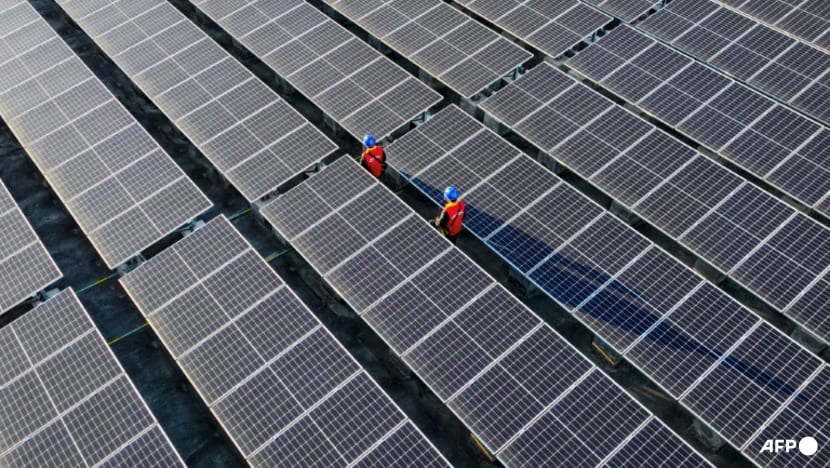Commentary: Southeast Asia solar panel manufacturers are over-reliant on American demand
Steep tariffs on solar panels put the region's manufacturers at risk and hamper installations in the US, says Sita Rahmani of the Energy Studies Institute.


This audio is generated by an AI tool.
SINGAPORE: Washington is planning to introduce steep tariffs on solar cells from Southeast Asian manufacturers, following a year-long investigation by the US Department of Commerce on “unfair trade practices”.
The tariffs, announced on Apr 22, target companies in Cambodia, Malaysia, Thailand and Vietnam, and run as high as 3,400 per cent.
The investigation found that companies in each country benefited from subsidies from the Chinese government, making their products cheaper and American products uncompetitive. The US’ International Trade Commission will finalise the tariffs in June.
Though proponents may celebrate the tariffs as victory for American solar manufacturers, this development adds more tension to global trade.
Importers of solar cells are familiar with tariffs, as multiple US administrations have applied them to protect the domestic industry since 2011. Last month’s announcement was the highest yet.
Given this new level, many are concerned about the increase in expenses for solar installations in the US. For Southeast Asia manufacturers, questions linger on whether they can survive a downturn in US demand.
GROWTH IN SOUTHEAST ASIA SOLAR MANUFACTURING
Cambodia, Malaysia, Thailand and Vietnam collectively play a key role in the supply chain of solar modules, accounting for 20 per cent of global exports in 2023. These countries supply 80 per cent of the US’s solar equipment imports.
The solar industry in Southeast Asia witnessed significant growth after 2012. Chinese companies shifted their production to the region, in response to US tariffs imposed to curb underpriced Chinese-made solar panels.
China dominates all stages of the global solar supply chain, and manufacturers in Southeast Asia and other nations rely on Chinese upstream inputs such as polysilicon, the raw material of solar cells. Polysilicon production is hard to shift elsewhere because it requires heavy capital upfront, constant access to raw materials and significant energy. With massive government support, China has the competitive advantage.
NEED TO REDUCE RELIANCE ON FOREIGN DEMAND
Southeast Asia has seen a slowdown of solar panel production since mid-2024, after a US tariff reprieve expired. Chinese-linked companies operating in Southeast Asia found that their profit margin, which could reach as high as 40 per cent, was eroded. Continued losses from oversupply and fierce price competition with China's top solar firms might have contributed to the situation.
Trump’s tariff announcements will put more pressure on manufacturers in Southeast Asia. This situation underscores the vulnerability of the regional solar industry’s dependence on US exports.
Foreign investment can bring positive spillover effects to host countries; however, there is a risk when it is unrelated to domestic demand.
For example, Malaysia has a solar panel manufacturing capacity of 23.6 gigawatts, but its installed capacity is only 4.2 gigawatts, leaving it vulnerable to an abrupt change in export demand. Other solar manufacturing countries in Southeast Asia have similar imbalances between export and domestic demands.
At present, solar installation in the region lacks ambition owing to multiple factors, including continued dependence on fossil fuels, regulatory hurdles and grid connectivity issues.
The increase in Chinese solar manufacturing investment in Laos and Indonesia, nations unaffected by import duties, since 2022 signals the expansion of production bases. However, the move is arguably for short-term gains, as the US is likely to extend its trade measures to close any loophole.
Southeast Asia may attempt to diversify export markets; however, over-dependence on foreign demand should be managed carefully. Considering global trade restrictions, domestic markets in Southeast Asia may serve as hedges against external risks.
Indeed, this is a golden opportunity for Southeast Asian economies to ramp up their own solar power capacity. This will help reduce their vulnerabilities to price volatility associated with fossil fuel markets, meet decarbonisation targets and prepare for the growing demand for green electricity within Southeast Asia.
IMPLICATIONS FOR THE US SOLAR INDUSTRY
Will Trump’s tariffs on Southeast Asian manufacturers boost the American solar industry?
A US study in 2024 found that solar tariffs led to some gains for US manufacturers, but higher prices for consumers and losses in environmental benefits.
Industrial policy such as financial incentives and manufacturing tax credits is viewed as the more efficient approach for supporting the solar industry, as opposed to reliance on trade policy. Nevertheless, more evidence is necessary to determine the effect of high import tariffs on the solar industry.
US solar production and supply chain growth are also contingent upon Trump’s climate policies, including his decisions to undermine the Inflation Reduction Act (IRA). The policy, signed by the Biden administration in 2022, supports clean energy projects through incentives and tax credits, enabling a four-fold increase in solar manufacturing capacity in two years.
Reversing the IRA is a poor decision, as it could dampen long-term industrial strategies, hinder job growth and cause the US to fall far behind its peers in meeting climate goals.
Despite sector consolidation and price adjustments in the short to medium term, China is expected to maintain its market position and cost competitiveness. It will take years for American solar factories to catch up.
In the short and medium term, solar panel price hikes will affect US consumers, possibly slowing solar panel installations as developers navigate new constraints.
Current developments also highlight the dynamic nature of the global solar industry. Achieving clean energy targets means that governments will need to adapt to changing trade policies and market conditions.
Sita Rahmani is Research Fellow at Energy Studies Institute, National University of Singapore.



















